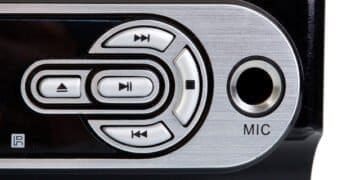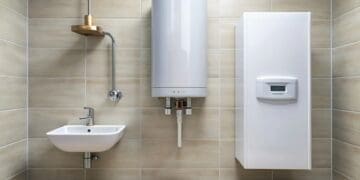The home automation industry is experiencing remarkable growth, with projections indicating a surge from USD 64.58 billion in 2020 to USD 163.24 billion by 2028,at a Compound Annual Growth Rate (CAGR) of 12.3%.
This flourishing expansion is driven by the increasing demand for smart home systems and devices that offer enhanced convenience, energy efficiency, and security, aligning with the global focus on eco-friendly practices.
As consumers embrace the benefits of home automation solutions and the industry continues to integrate cutting-edge technologies like artificial intelligence and voice-activated controls, the market for smart home automation systems is poised for sustained growth.
This article will delve into the top 10 trends shaping the home automation industry in 2024, providing insights into emerging innovations, market dynamics, and the evolving landscape of this burgeoning business.
Understanding Home Automation

Definition and Overview
Home automation, also known as domotics, refers to the automatic control of electronic devices and systems within a home environment.
It involves the integration of smart devices and technologies that work together intelligently to enhance comfort, security, efficiency, and overall home management.
A smart home is equipped with various interconnected devices and systems that can be remotely controlled and accessed, often through a central home automation hub or gateway.
The core concept of home automation is the seamless connection and control of different home appliances, gadgets, and systems, literally from anywhere in the world, using cutting-edge technologies like artificial intelligence (AI) and the Internet of Things (IoT).
This transforms living spaces into nodes on a global network, enabling convenient remote control and automation of various aspects, such as lighting, heating, appliances, security systems, and entertainment.
Benefits of Home Automation
Home automation offers numerous benefits, including:
- Convenience and accessibility: Users can manage and control various aspects of their homes remotely, either through automated routines, voice assistants, or smartphone applications, providing unparalleled convenience and accessibility.
- Energy efficiency and cost savings: By automating systems like HVAC, lighting, and appliances, home automation optimizes energy usage, leading to reduced energy consumption and lower utility bills.
- Enhanced security and safety: Smart security systems and surveillance setups allow homeowners to monitor their properties even when away, providing an added layer of security and peace of mind.
- Personalization and customization: Home automation systems can be tailored to individual preferences and schedules, enabling personalized control over various aspects of the living environment.
- Time-saving and simplified routines: Automating repetitive tasks, such as brewing coffee in the morning or watering the lawn, frees up time and simplifies daily routines.
Key Components and Technologies
A typical home automation system comprises several key components and technologies:
- Smart speakers and voice assistants: Devices like Google Home and Amazon Echo enable voice control and access to information, allowing users to manage various aspects of their homes through voice commands.
- Smart hubs or gateways: These central units act as the “brains” of the smart home system, facilitating the connection and management of multiple devices from a single point.
- Smart switches, plugs, and sensors: Smart switches replace traditional switches, while Wi-Fi-enabled smart plugs transform regular appliances into smart devices. Smart sensors detect motion, temperature, humidity, and other environmental conditions, enabling automated actions and alerts.
- Internet of Things (IoT) devices: Home automation relies on a network of interconnected IoT devices, which are embedded with sensors, software, and internet connectivity, enabling data collection, monitoring, and control.
- Communication protocols: IoT devices connect to the internet and each other using various communication protocols, such as Wi-Fi, Bluetooth, ZigBee, Z-Wave, and Thread, facilitating seamless integration and interoperability.
By leveraging these components and technologies, home automation systems provide users with enhanced control, convenience, efficiency, and security within their living spaces.
I am glad you are enjoying this content… I have other articles related to this topic… Click Here
Top Home Automation Companies

Company Profiles and Offerings
The home automation market is dominated by several prominent companies that offer a wide range of smart home products and services.
These companies often provide comprehensive home automation systems that integrate multiple devices, allowing homeowners to manage their homes remotely through mobile apps or voice commands.
Some of the top players in the home automation industry include:
- Amazon: Known for its Alexa voice assistant and Echo smart speakers, Amazon offers a range of smart home devices, including smart lights, plugs, and security cameras. The Echo Hub acts as a smart home dashboard, enabling users to control various devices and view security camera feeds.
- Google: With its Google Assistant and Nest products, Google offers smart thermostats, security cameras, and smart speakers, among other devices. Users can create routines for their devices to work together and perform multiple actions simultaneously.
- Apple: Apple’s HomeKit platform allows users to control their smart home devices with Siri voice commands or through the Apple Watch. It also enables the creation of scenes to trigger multiple devices simultaneously.
- Samsung: Samsung’s SmartThings platform works with hundreds of compatible devices, including lights, cameras, voice assistants, locks, and thermostats. The SmartThings Hub acts as the brain of the smart home, connecting wirelessly with various devices and enabling them to work together.
- Tado: This German company specializes in smart heating and energy management products, such as Smart Radiator Thermostats, Smart Thermostats, and Smart AC Controls. Their products are designed to work with various heating systems and can potentially save up to 31% on heating bills.
- LG ThinQ: LG’s ThinQ platform allows users to control and monitor their LG smart appliances, such as refrigerators, washing machines, and air conditioners, from their phones or other smart devices. The appliances can be controlled remotely and set to automate routines.
Unique Features and Strengths
Many home automation companies focus on developing unique features and strengths to differentiate themselves in the market. For example:
- Eufy offers easy-to-use smart home devices, including security cameras with facial recognition and local storage, as well as robotic vacuums. Their products are known for their affordability and user-friendliness.
- Govee provides a range of smart home solutions with a focus on aesthetic enhancement and data-driven insights. Their products include LED strip lights that can dance to music or respond to voice commands, as well as home security systems.
- Arenti specializes in indoor and outdoor cameras, baby monitors, and pet cameras, offering a balance between quality and cost-effectiveness. Their cloud storage solutions are hosted on Amazon’s AWS for secure data storage.
- SwitchBot offers intelligent products that can upgrade traditional door locks, control curtains, and automate light switches. Their products, such as the SwitchBot Hub Mini and Hub 2, act as smart home hubs compatible with various voice assistants.
- Vivint is a dominant force in the U.S. smart home market, offering innovative products and solutions with a focus on enhancing security and convenience. Their products, including the Vivint Smart Hub, doorbell cameras, and smart thermostats, are compatible with popular smart home platforms.
- Rachio specializes in smart yard solutions, such as sprinkler controllers and water-saving tools, designed to optimize water use and plant health. Their products employ weather intelligence and offer community support through an online forum.
Product and Service Ranges
The product and service ranges of home automation companies can vary significantly, with some offering a comprehensive suite of solutions while others specialize in specific areas. For instance:
- Companies like Amazon, Google, and Apple offer a wide range of smart home devices, including speakers, displays, cameras, and smart plugs, as well as integration with third-party products.
- Samsung’s SmartThings platform supports hundreds of compatible devices, providing users with a vast selection of options to build their smart home ecosystem.
- Tado and Rachio focus on specific areas, such as smart heating and cooling solutions, and smart yard management, respectively.
- LG ThinQ primarily offers smart appliances, while Eufy and Arenti concentrate on security cameras, robotic vacuums, and home monitoring solutions.
- SwitchBot and Govee provide innovative products for automating traditional devices, such as door locks, curtains, and lighting, as well as aesthetic enhancements through smart lighting solutions.
- Vivint offers a comprehensive range of smart home products, including security systems, thermostats, and smart locks, catering to various aspects of home automation.
By offering diverse product and service ranges, these companies cater to the varying needs and preferences of homeowners, enabling them to create customized smart home setups tailored to their specific requirements.
Choosing the Right Solution

Assessing Your Needs and Budget
When embarking on a smart home journey, it’s crucial to assess your specific needs and establish a realistic budget.
Begin by envisioning how you want the smart home system to enhance your daily life, whether it’s through increased convenience, improved security, energy efficiency, or seamless integration with virtual assistants like Alexa or Google.
Prioritize the features that align with your goals and preferences, as not every smart home capability may be equally valuable for your situation.
Next, set a budget that reflects your priorities and desired experiences.
Consider the upfront costs of devices, installation fees (if opting for professional installation),ongoing subscription fees for services like cloud storage or cellular data, and potential future expansion costs.
Approach budgeting as an exciting step toward realizing your ideal smart home, balancing monetary considerations with the convenience and peace of mind you aim to achieve.
Factors to Consider (Integration, Scalability, User-Friendliness)
When choosing a smart home ecosystem, evaluate the compatibility and expandability of leading brands like Amazon Alexa, Apple HomeKit, Google Home, and Samsung SmartThings.
Focus on the ecosystem whose strengths provide the best fit based on your existing technology, preferred voice assistant, must-have features, and hardware needs.
Prioritize a platform that seamlessly integrates with the devices you already own or plan to acquire, ensuring a cohesive and interoperable smart home experience.
Scalability is another crucial factor to consider.
Select a smart hub or ecosystem that allows for future expansion, supporting a wide range of smart devices and offering compatibility with popular third-party products.
This flexibility ensures that your smart home can evolve alongside your changing needs and technological advancements.
User-friendliness is equally important.
Opt for a smart hub with an intuitive interface and easy-to-navigate app, enabling you to set up, control, and customize your smart devices effortlessly.
Look for features like automation, scheduling, and customization options that allow you to tailor your smart home to your preferences.
Want to learn more… Click Here
Professional Installation vs. DIY
When it comes to setting up your smart home system, you have the option of professional installation or a do-it-yourself (DIY) approach.
Each choice has its advantages and considerations:
- DIY Installation:
- Suitable for tech-savvy individuals seeking flexibility and cost savings.
- Requires a robust understanding of network configurations, device interoperability, and troubleshooting skills.
- May be manageable for basic systems with a few sensors and a central hub, but becomes more challenging with complex setups involving advanced features like smart locks, networked smoke alarms, and cameras.
- Demands a substantial time commitment for research, hands-on work, and ongoing maintenance.
- Professional Installation:
- Offers convenience and expertise, ensuring optimal device placement, fine-tuned sensor configurations, and seamless integration.
- Professionals adhere to industry standards, minimizing the risk of errors in setup or configuration, enhancing overall system reliability.
- Can expedite the installation process, minimizing disruption to your household.
- Typically more expensive than DIY but may be worthwhile for those less technically inclined or with sophisticated systems.
Ultimately, the choice between DIY and professional installation depends on factors such as your technical proficiency, the complexity of the system, budget considerations, and the time investment involved.
For intricate or specialized setups, professional installation may be the more prudent option to maximize the capabilities and security of your smart home system.
Home Automation Trends and Future

Emerging Technologies and Innovations
The home automation industry is rapidly evolving, with emerging technologies like artificial intelligence (AI) and machine learning driving innovation.
AI integration in smart home devices will further enhance automation and personalization, enabling systems to anticipate user needs and preferences.
One key trend is the Internet of Things (IoT), which allows seamless connectivity between devices, enabling intelligent interactions. For instance, your fridge could notify your smartphone when you’re running low on groceries.
Impact on Energy Efficiency and Sustainability
Smart home technologies, powered by AI, offer significant opportunities for improved energy efficiency and sustainability. For example, AI algorithms can optimize energy usage by analyzing consumption patterns and making real-time adjustments.
Integrating AI into smart home systems reduces energy waste, contributing to lower utility bills and a smaller carbon footprint. This aligns with the global focus on eco-friendly practices, driven by climate change concerns.
Don’t wait, other post are waiting for you!!!
Integration with AI and Smart Assistants
The integration of AI and smart assistants, like Alexa, enhances automation and personalization. As AI algorithms advance, systems will increasingly anticipate user needs and preferences, enabling seamless interactions through voice commands.
This integration of AI and smart assistants will enable intelligent interactions within smart homes, facilitating seamless automation and personalization.
For example, AI-powered smart home systems can analyze data from user interactions, enabling developers to refine and innovate products based on insights into user behaviors, preferences, and pain points.
Integrating AI and machine learning algorithms will further enhance the functionality of AI-powered smart home devices, making them more responsive and intuitive.
Conclusion
The home automation industry is undergoing a remarkable transformation, driven by advancements in artificial intelligence, the Internet of Things, and the integration of smart assistants.
As technologies continue to evolve, smart home systems will become increasingly intuitive, personalized, and efficient. These innovations will not only enhance convenience but also contribute to energy conservation and sustainability, aligning with global environmental goals.
Looking ahead, the future of home automation promises seamless user experiences, where devices anticipate our needs and adapt to our preferences seamlessly.
However, as we embrace these technological advancements, it is crucial to prioritize security, privacy, and ethical considerations. With mindful implementation and continued innovation, the home automation industry holds the potential to redefine our living spaces, offering unparalleled comfort, efficiency, and peace of mind.
FAQs
1. What does the future hold for home automation?
The future of home automation looks promising with the integration of more sophisticated technologies and the expansion of the Internet of Things (IoT).
Significant developments are expected particularly in the areas of artificial intelligence (AI) and machine learning (ML), enhancing the capabilities and functionality of home automation systems.
2. How is the home automation market expected to grow?
The global Home Automation Market is on a trajectory of substantial growth. It was valued at USD 64.58 billion in 2020 and is projected to soar to USD 163.24 billion by 2028.
This growth represents a Compound Annual Growth Rate (CAGR) of 12.3% during the forecast period from 2021 to 2028.
3. What are the current trends in automation?
Currently, automation is increasingly incorporating artificial intelligence (AI) and machine learning (ML) in testing processes. This trend allows for more efficient and accurate testing.
Additionally, there is a growing trend towards ‘shift left’ testing, which involves conducting more automated tests earlier in the development cycle during the CI/CD pipeline to detect bugs sooner and more cost-effectively.
4. What is the growth potential of the home automation market in India?
The home automation market in India has shown impressive growth potential. Valued at $1,790.9 million in 2018, it is forecasted to escalate to $13,574.1 million by 2026.
This growth indicates a CAGR of 29.8% during the forecast period from 2019 to 2026, highlighting rapid adoption and expansion in the region.





















































